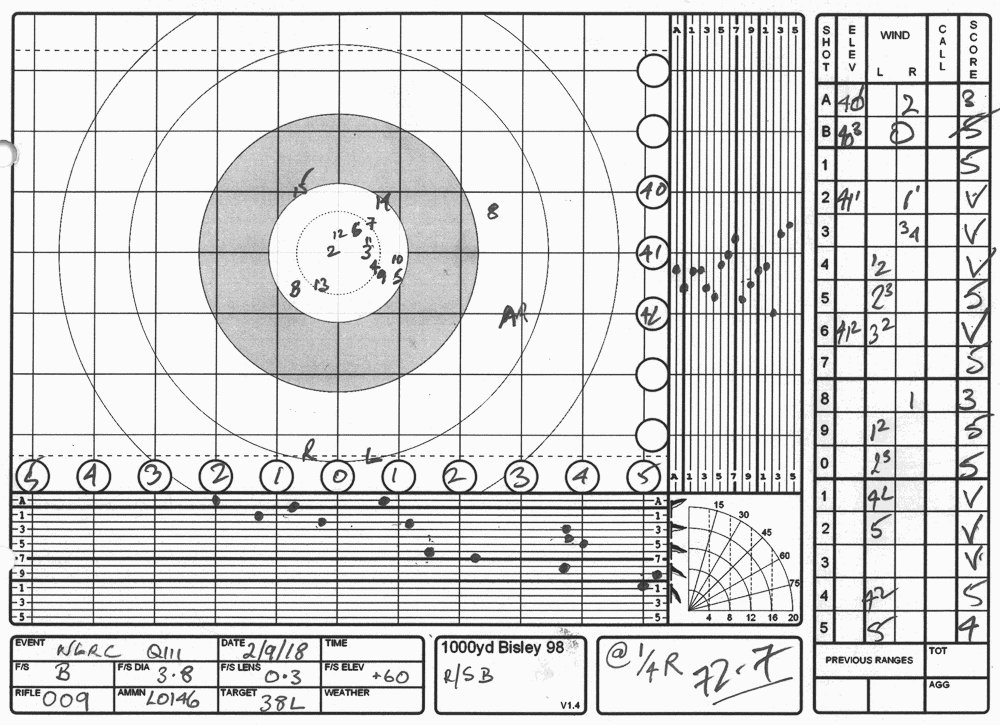Re: Scope Adjustment and Zeroing
Posted: Wed Oct 24, 2018 12:41 pm
Ah!! I get it so after zeroing at whatever range you would log the changes for change in distance and any windage for future use if those conditions are repeated?
All people seeking membership must contact admin after registering to be validated.
https://mail.full-bore.co.uk/
Couldn't disagree more.Rockhopper wrote:there is little point taking any notice of the numbers, all you need to do it count the number of clicks and in which direction you are turning it
Not quite. Again, record absolute values. The change in elevation required from 500 to 600 is not the same as the change from 900 to 1000.Madhatter wrote:Ah!! I get it so after zeroing at whatever range you would log the changes for change in distance and any windage for future use if those conditions are repeated?
Slightly disagree with this, especially if sighters are 'convertible'. With a little experience, I know what kind of group to expect. If my 1st shot is more than 1/2 that diameter away from the centre, I'll make a correction. That improves my chances of not needing to correct on the second (and improves my chances of 'converting' the second, if applicable). Even without conversions, I'd rather be starting a scoring string without having just moved the sights, given the choice. I can correct for the adjustment and 'see' the group size and centre (as if the adjustment wasn't made) either mentally or on a plot sheet. Admittedly I've never had much issue with cold bore shots being out of the group - presumably due to using stiff match barrels. The first shot out of a clean bore at long range, however, certainly has to be taken with a big pinch of salt!Maggot wrote:Another mistake I see regulrly is when people are given 2 sighters and adjust on the first (usually cold barrel) shot. Not until the second round goes down will you have any idea how close your MPI was. If you adjust on a bad shot, you compound the error.
Yep. Known as elevation or numbers on the rifle. As Rockhopper points out this can be easier said than done with some scopes.Madhatter wrote:Ah!! I get it so after zeroing at whatever range you would log the changes for change in distance and any windage for future use if those conditions are repeated?
Horses for courses Bob. I have just seen so many people shoot a pants first sighter, adjust on it and put themselves further in the crap than if they had taken both. In my world sighters are not convertible in any event, so use them to the best advantage (2 confirms 1). Actually in some matches we dont get any, and we dont get plot sheets either so its what you see is what you get. Then its usually into a 50 round match with those being your only sighters at the longest range. Different strokes mate.rox wrote:Slightly disagree with this, especially if sighters are 'convertible'. With a little experience, I know what kind of group to expect. If my 1st shot is more than 1/2 that diameter away from the centre, I'll make a correction. That improves my chances of not needing to correct on the second (and improves my chances of 'converting' the second, if applicable). Even without conversions, I'd rather be starting a scoring string without having just moved the sights, given the choice. I can correct for the adjustment and 'see' the group size and centre (as if the adjustment wasn't made) either mentally or on a plot sheet. Admittedly I've never had much issue with cold bore shots being out of the group - presumably due to using stiff match barrels. The first shot out of a clean bore at long range, however, certainly has to be taken with a big pinch of salt!Maggot wrote:Another mistake I see regulrly is when people are given 2 sighters and adjust on the first (usually cold barrel) shot. Not until the second round goes down will you have any idea how close your MPI was. If you adjust on a bad shot, you compound the error.
..
So how does that work if your elevation adjustment is more than one whole turn of the dial?rox wrote:Couldn't disagree more.Rockhopper wrote:there is little point taking any notice of the numbers, all you need to do it count the number of clicks and in which direction you are turning it
Always work in absolute values. You (and others) can verify absolute values.
Winding up from <wherever the sight was left at> is making several assumptions - assumptions that could see you outside the safety envelope.
..
Read markings that exist for that purpose (if present), or start from a known fixed point, like first '0' encountered when winding up from the minimum elevation; count revolutions x mins/mils per rev, plus mins/mils/clicks/graduations for the final (partial) revolution.Rockhopper wrote:So how does that work if your elevation adjustment is more than one whole turn of the dial?
